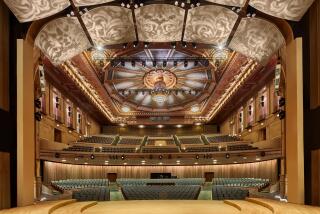TUSTIN : Reopened Center Has Friendlier Ambience
Public buildings should be friendly and inviting, not massive and intimidating, said John Bates, the architect who remodeled the Tustin Civic Center on Centennial Way.
“With the often adversarial relation between the people and government, I think we need a building that will pull them together,” said Bates, president of Laguna Hills-based John Bates & Associates, which designed and renovated the Civic Center.
“We need to say to the citizens: ‘Come in; we’re your friends,’ ” Bates said.
Plenty of that inviting feeling is evident--from the wishing well in the courtyard to the colorful window panes--in the Civic Center, which opened its doors to the public for the first time in two years on Aug. 30.
After an $11.3-million renovation, the new complex features second-floor additions to City Hall and the Police Department, with a new skylight atrium lobby to connect the two buildings.
The Community Center and the City Council chambers were expanded, again adding a skylight atrium to connect the facilities.
Public counters are bigger, while an expanded parking lot can now accommodate 320 vehicles, compared to about 200 in the past.
Inside and outside, it’s different from the old Civic Center, built in the 1950s.
Bates said the new design attempts to capture the image that the city seeks to project.
“Tustin has a quest for some connection with the past,” Bates said. “It has the Old Town area, with some elements of the early Spanish grants and settlements. We used this Old Town imagery to the design of the project.”
City officials started planning for a bigger Civic Center about nine years ago, as the old building was getting too cramped for the growing city.
Bates’ contract with the city was signed in 1986, but work didn’t begin in earnest until 1991.
City operations moved to a temporary facility on Del Amo Avenue when construction started. The Police Department building was built first and opened last year.
Construction money came from the sale of bonds and from fees paid by developers of various East Tustin projects.
Bates said the new Civic Center is a contemporary interpretation of the Santa Barbara architectural style that was popular for public buildings in the 1930s.
The style features stucco walls, multi-paned windows with precast concrete sills, use of concrete trims and column bases, and clay tile roofs. The architecture is also often called Mediterranean style.
The Santa Barbara style is also popular for residences, Bates said. In some cities, like Santa Ana, certain features of the architecture, such as the red tile roofs, are common in newly constructed buildings, including shopping malls.
The architectural style is called Santa Barbara because such types of buildings are common in that California town, Bates said.
He said this style is becoming popular again as architects try to find a “humanist” approach to public buildings.
“Public buildings must be user-friendly, and this is one of the most user-friendly styles,” he said.
More to Read
Sign up for Essential California
The most important California stories and recommendations in your inbox every morning.
You may occasionally receive promotional content from the Los Angeles Times.










